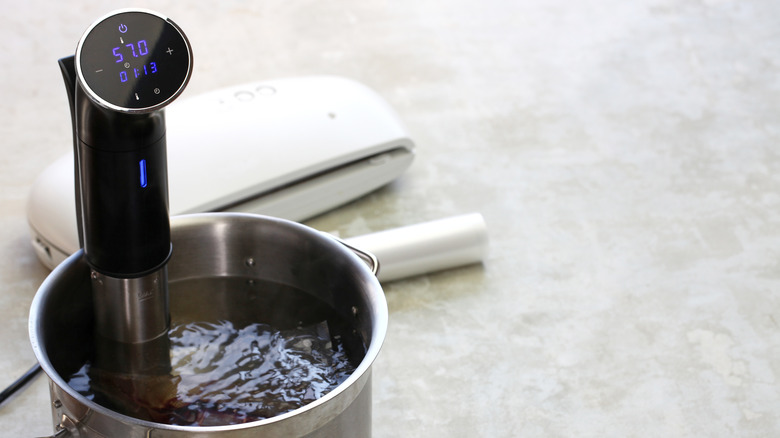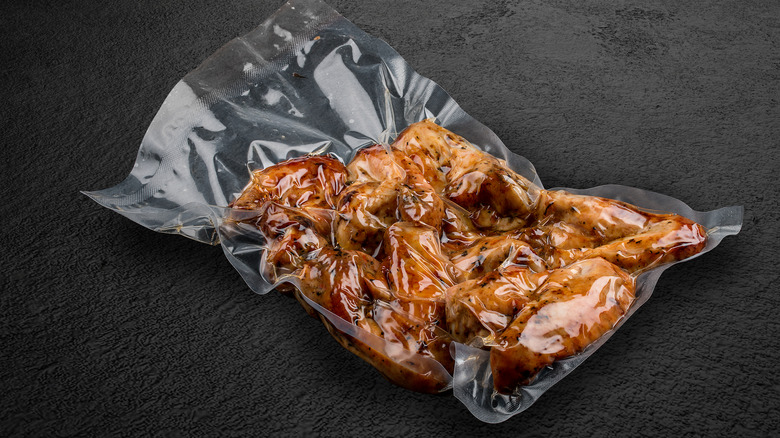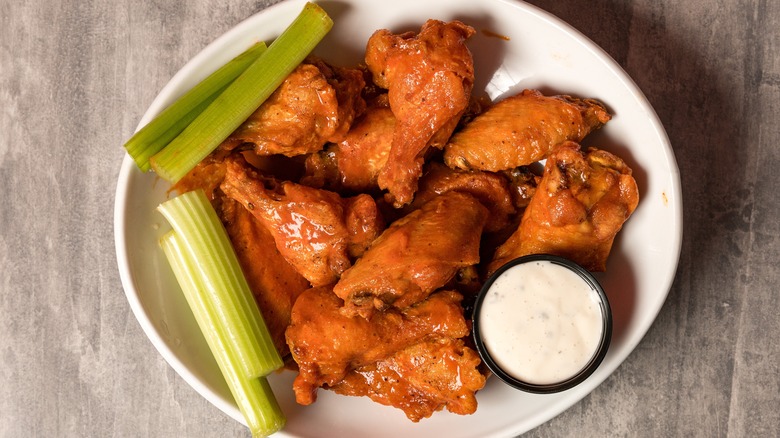Sous Vide Is A Truly Underrated Method For Cooking Wings
When cooking chicken wings, the main question is usually whether to bake, grill, or fry them. However, whichever method you choose, there's a reasonable chance you'll end up with imperfect wings. Because of their small size and bone-to-meat ratio, it's hard to end up with that ideal balance of juicy, tender meat and crispy skin.
Sous vide is a surprising savior for cooking wings to perfection. To the uninitiated wondering what sous vide is, it's a method of cooking where food is tightly sealed in a plastic bag, and then submerged in a circulating water bath that's heated to a constant temperature using an immersion tool. Sous vide is best known for allowing you to perfectly precision cook steak, creating unbeatable tenderness in even relatively tough cuts like flank steak. The technique works equally well with other meats: Sous vide turkey breast, for example, yields succulent, tender turkey that other cooking methods struggle to match.
On its own, sous vide is unable to give you crispy wings, as the cooking takes place inside a bag. Instead, the secret is to use the sous vide for what it does best: Slow cooking until your wings are perfectly tender. Then pat them dry, and sear at high heat for a short time. The result is wings with a crispy exterior and meat inside that's fall-off-the-bone tender.
Secrets for success when sous vide cooking chicken wings
Sous vide cooking doesn't need to be super costly or complex. Immersion circulators can be found for less than $100, and while commercial vacuum sealers can be very expensive, countertop varieties exist at a similar price point to basic sous vide machines. Moreover, you don't even need a vacuum sealer to sous vide — you can use food-safe zipper lock bags instead. Simply add your wings to the bag then submerge it, keeping the bag's opening above the water level. The water pressure will force out any air inside, and then you can seal it and leave it to cook.
Set the water temperature to 160 degrees Fahrenheit, and cook the wings for two hours. Once removed, the wings should be dried thoroughly before frying. Since frying uses the minimal possible time to crisp up the skin (about three minutes), it's the only way to finish sous vide wings without overcooking the meat inside. Drying before frying is important because wet wings will not crisp up evenly, any lingering moisture can cause hot oil to spit while you're frying them. Leave your wings uncovered in the fridge overnight to dry, or, if you can't wait, dry them well with paper towels instead.
Why sous vide is so good for cooking wings
Sous vide cooking gives you precise control of the temperature, and cooking low and slow makes it an ideal cooking method for elevating cheap cuts of meat. As the chicken wings slowly cook at a low temperature, the collagen in the connective tissue softens and melts, making the meat deliciously tender while basting in its juices. While cooking sous vide and then drying your wings before frying does undoubtedly add a lot of time, it's mostly passive — you're free to get on with other things while your wings are in the water bath.
Sous vide can be used whenever you'd like chicken wings that are tender on the inside, yet crispy on the outside. For example, you can take a classic Buffalo chicken recipe to the next level by using this technique. Many sous vide recipes for Buffalo wings suggest simply salting your wings before they sous vide, then coating them in Buffalo sauce after they've been dried and fried. However, you could also experiment with adding some Buffalo sauce, or ingredients like garlic, smoked paprika, and sugar, into the bag with your chicken wings. This way, you'll have additional flavor penetrating the meat, as well as a delicious sauce.


